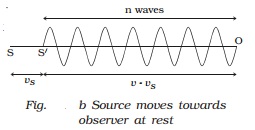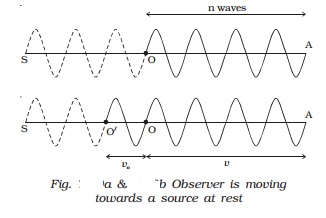Chapter: 11th 12th std standard Class Physics sciense Higher secondary school College Notes
Doppler effect : Different cases and Applications

Doppler effect
The
whistle of a fast moving train appears to increase in pitch as it approaches a
stationary observer and it appears to decrease as the train moves away from the
observer. This apparent change in frequency was first observed and explained by
Doppler in 1845.
The
phenomenon of the apparent change in the frequency of sound due to the relative
motion between the source of sound and the observer is called Doppler effect.
The
apparent frequency due to Doppler effect for different cases can be deduced as
follows.
(i) Both source and observer at
rest
Suppose
S and O are the positions of the source and the observer respectively. Let n be
the frequency of the sound and v be the velocity of sound. In one second, n
waves produced by the source travel a distance SO = v (Fig. a).
The
wavelength is λ = v/n

(ii) When the source moves towards
the stationary observer
If
the source moves with a velocity vs towards the stationary observer,
then after one second, the source will reach S′, such that SS′ = vs.
Now n waves emitted by the source will occupy a distance
of
(v?vs) only as shown in Fig. b.
Therefore
the apparent wavelength of the sound is
λ
= (v-vs)/n
The
apparent frequency
n?
= v/ λ? = (v/v-vs)n ????..(1)
As
n′ > n, the pitch of the sound appears to increase.

When the source moves away from the
stationary observer
If
the source moves away from the stationary observer with velocity vs, the
apparent frequency will be given by
n?
= (v/[v-(-vs)])n = (v/[v+vs])n ????.(2)
As
n′ < n, the pitch of the sound appears to decrease.
(iii) Source is at rest and
observer in motion
S
and O represent the positions of source and observer respectively.
The
source S emits n waves per second having a wavelength λ = v/ n .
Consider
a point A such that OA contains n waves which crosses the ear of the observer
in one second (Fig. a). (i.e) when the first wave is at the point A, the nth
wave will be at O, where the observer is situated.

When the observer moves towards the
stationary source
Suppose
the observer is moving towards the stationary source with velocity vo.
After one second the observer will reach the point O′ such that OO′ = vo.
The number of waves crossing the observer will be n waves in the distance OA in
addition to the number of waves in the distance OO′ which is equal to vo/λ
as shown in Fig. b.
Therefore,
the apparent frequency of sound is
n′
= n + vo/ λ = n +(v0/v)n
∴ n′ = ((v+v0)/v)n
???..(3)
As
n′ > n, the pitch of the sound appears to increase.
When
the observer moves away from the stationary source
n′
= [v +(-v0)/v]n
n′
= ( v-vo / v )n
As
n′ < n, the pitch of sound appears to decrease.
Note
: If the source and the observer move along the same
direction,
the equation for apparent frequency is
n′
= (v-v0 / v-vs )n
Suppose
the wind is moving with a velocity W in the direction of propagation of sound,
the apparent frequency is
n′
= ([v+W-v0]/ [v+W-vs])n
Applications of
Doppler effect
(i) To measure the speed
of an automobile
An
electromagnetic wave is emitted by a source attached to a police car. The wave
is reflected by a moving vechicle, which acts as a moving source. There is a
shift in the frequency of the reflected wave. From the frequency shift using
beats, the speeding vehicles are trapped by the police.
(ii)
Tracking a satellite
The
frequency of radio waves emitted by a satellite decreases as the satellite
passes away from the Earth. The frequency received by the Earth station,
combined with a constant frequency generated in the station gives the beat
frequency. Using this, a satellite is tracked.
(iii)
RADAR (RADIO DETECTION AND RANGING)
A
RADAR sends high frequency radiowaves towards an aeroplane. The reflected waves
are detected by the receiver of the radar station. The difference in frequency
is used to determine the speed of an aeroplane.
(iv)
SONAR (SOUND NAVIGATION AND RANGING)
Sound waves generated
from a ship fitted with SONAR are transmitted in water towards an approaching
submarine. The frequency of the reflected waves is measured and hence the speed
of the submarine is calculated.
Related Topics